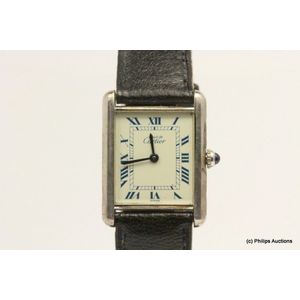Cartier Sterling Silver Quartz Watch with Leather Strap
You must be a subscriber, and be logged in to view price and dealer details.
Subscribe Now to view actual auction price for this item
When you subscribe, you have the option of setting the currency in which to display prices to $Au, $US, $NZ or Stg.
- Sterling Silver - Sterling silver is a mixture of 92.5% pure silver and 7.5% of another metal, usually copper. Fine silver is 99.9% pure silver, and is relatively soft and the addition of the very small amount of copper gives the metal enough strength and hardness to be worked into jewellery, decorative and household objects.
- Ivory - Ivory is a hard white material that comes from the tusks of elephants, mammoth, walrus and boar, or from the teeth of hippopotamus and whales. The ivory from the African elephant is the most prized source of ivory. Although the mammoth is extinct, tusks are still being unearthed in Russia and offered for sale.
Ivory has been used since the earliest times as a material for sculpture of small items, both in Europe and the east, principally China and Japan.
In Asia ivory has been carved for netsuke, seals, okimono, card cases, fan supports, animals and other figures and even as carved tusks.
In the last 200 years in Europe ivory has been used to carve figures, for elaborate tankards, snuff boxes, cane handles, embroidery and sewing accessories, in jewellery and as inlay on furniture. Its more practical uses include being used for billiard balls, buttons, and a veneers on the top of piano keys.
The use and trade of elephant ivory have become controversial because they have contributed to Due to the decline in elephant populations because of the trade in ivory, the Asian elephant was placed on Appendix One of the Convention on International Trade in Endangered Species (CITES), in 1975, and in January 1990, the African elephant was similarly listed. Under Appendix One, international trade in Asian or African elephant ivory between member countries is forbidden. Unlike trade in elephant tusks, trade in mammoth tusks is legal.
Since the invention of plastics, there have been many attempts to create an artificial ivory
This item has been included into following indexes:
Visually similar items

A ladies gold Bucherer wristwatch. 18ct yellow gold, marked to dial Bucherer with manual wind movement, circa 1960's, with rounded square shaped case, white dial, black and gold baton markers, two hands, fitted to a black leather strap

A gents Omega de Ville wristwatch, stainless steel, quartz movement, made as a smooth rectangular shaped case with brushed finish, white dial, baton markers, two hands, fitted to a leather strap

An Eterna-Matic Les Historiques, 1935, gents watch, c.2000, automatic movement, gold tone dial with date display, stainless steel case with leather strap, width 26 mm

A gents Gruen vintage wristwatch. Yellow gold cased, marked to dial, case and manual movement Gruen, with rounded square case, teardrop shaped lugs, white dial with luminous markers, two hands, sub dial, fitted to a black leather strap. N.B. Sub dial hands
